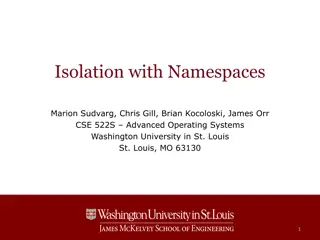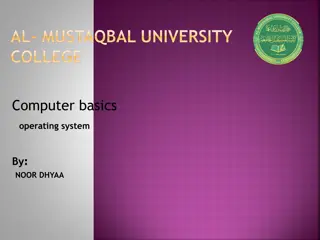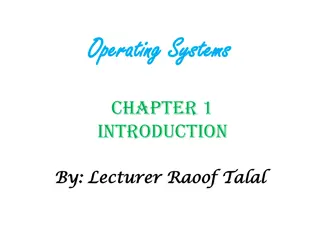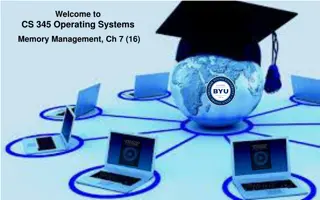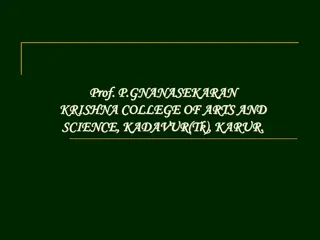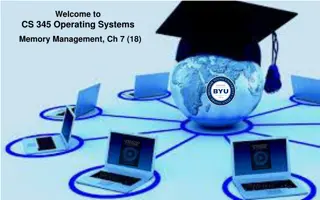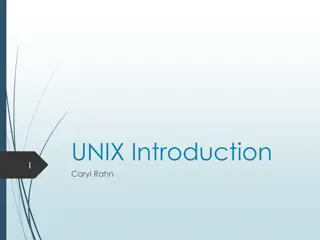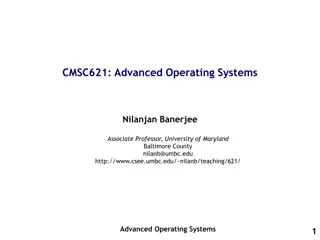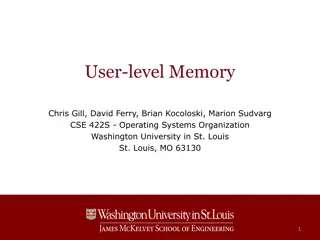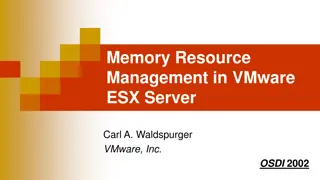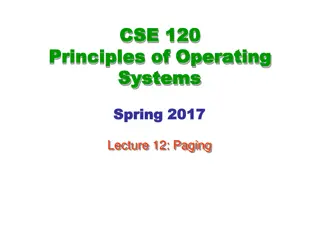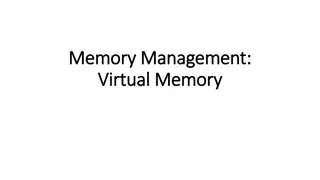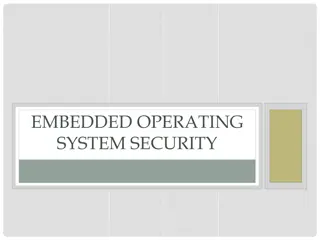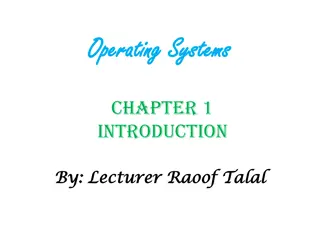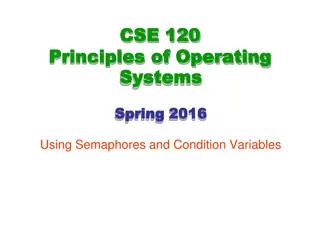Efficient Paging Mechanisms in Operating Systems
Today's lecture covers various paging mechanisms in operating systems, including optimizations for managing page tables efficiently, utilizing Translation Lookaside Buffers (TLBs) for faster translations, implementing demand-paged virtual memory, and advanced functionality like memory sharing, copy-on-write, and mapped files. The session also addresses the challenges of efficiency in memory access due to page table lookups and proposes solutions such as hardware support to cache translations in a Translation Lookaside Buffer (TLB).
Download Presentation

Please find below an Image/Link to download the presentation.
The content on the website is provided AS IS for your information and personal use only. It may not be sold, licensed, or shared on other websites without obtaining consent from the author.If you encounter any issues during the download, it is possible that the publisher has removed the file from their server.
You are allowed to download the files provided on this website for personal or commercial use, subject to the condition that they are used lawfully. All files are the property of their respective owners.
The content on the website is provided AS IS for your information and personal use only. It may not be sold, licensed, or shared on other websites without obtaining consent from the author.
E N D
Presentation Transcript
Operating Systems ECE344 Lecture 8: Paging Ding Yuan
Lecture Overview Today we ll cover more paging mechanisms: Optimizations Managing page tables (space) Efficient translations (TLBs) (time) Demand paged virtual memory (space) Recap address translation Advanced Functionality Sharing memory Copy on Write Mapped files 2 ECE344 Lecture 8: Paging Ding Yuan
Review: Page Lookups Example: how do we load 0x00007468 ? Physical Memory Virtual Address 0 0 0 0 4 6 7 8 Virtual page number Offset Physical Address 0x0002467 0x0002468 .. .. .. .. A 0x0002 468 page frame index .. .. .. .. 0x00006 0x00007 .. .. .. .. 0x0002 Page Table 3 ECE344 Lecture 8: Paging Ding Yuan
Review: Two-Level Page Tables Physical Memory Virtual Address Master page number Secondary Offset Physical Address Page table Page frame Offset Master Page Table Page frame Secondary Page Table 4 ECE344 Lecture 8: Paging Ding Yuan
Problems with Efficiency If OS is involved in every memory access for PT look up --- too slow (user<->kernel mode switch) Every look-up requires multiple memory access Our original page table scheme already doubled the cost of doing memory lookups One lookup into the page table, another to fetch the data Now two-level page tables triple the cost! Two lookups into the page tables, a third to fetch the data And this assumes the page table is in memory 5 ECE344 Lecture 8: Paging Ding Yuan
Solution to Efficient Translation How can we use paging but also have lookups cost about the same as fetching from memory? Hardware Support Cache translations in hardware Translation Lookaside Buffer (TLB) TLB managed by Memory Management Unit (MMU) 6 ECE344 Lecture 8: Paging Ding Yuan
Translation Look-aside Buffer (TLB) 7 ECE344 Lecture 8: Paging Ding Yuan
TLBs Translation Lookaside Buffers Translate virtual page #s into PTEs (not physical addrs) Can be done in a single machine cycle TLBs implemented in hardware Fully associative cache (all entries looked up in parallel) Cache tags are virtual page numbers Cache values are PTEs (entries from page tables) With PTE + offset, can directly calculate physical address TLBs exploit locality Processes only use a handful of pages at a time 16-48 entries/pages (64-192K) Only need those pages to be mapped Hit rates are therefore very important 8 ECE344 Lecture 8: Paging Ding Yuan
TLB Example (VPN,Offset) VPN Offset PPN VPN VPN->PPN PPN Offset TLB (PPN,Offset) 9 ECE344 Lecture 8: Paging Ding Yuan
TLB Example (VPN,Offset) 7 246 12 1 2 3 7 7 19 3 7->2 2 246 TLB (PPN,Offset) 10 ECE344 Lecture 8: Paging Ding Yuan
TLB Example: next reference (VPN,Offset) 7 248 12 1 2 3 7 7 19 3 7->2 2 248 TLB (PPN,Offset) 11 ECE344 Lecture 8: Paging Ding Yuan
Managing TLBs Address translations for most instructions are handled using the TLB >99% of translations, but there are misses (TLB miss) Who places translations into the TLB (loads the TLB)? Hardware (Memory Management Unit) [x86] Knows where page tables are in main memory OS maintains tables, HW accesses them directly Tables have to be in HW-defined format (inflexible) Software loaded TLB (OS) [MIPS, Alpha, Sparc, PowerPC] TLB faults to the OS, OS finds appropriate PTE, loads it in TLB Must be fast (but still 20-200 cycles) CPU ISA has instructions for manipulating TLB Tables can be in any format convenient for OS (flexible) 12 ECE344 Lecture 8: Paging Ding Yuan
Managing TLBs (2) OS ensures that TLB and page tables are consistent When it changes the protection bits of a PTE, it needs to invalidate the PTE if it is in the TLB Reload TLB on a process context switch Invalidate all entries (called TLB flush) Why? What is one way to fix it? When the TLB misses and a new PTE has to be loaded, a cached PTE must be evicted Choosing PTE to evict is called the TLB replacement policy Implemented in hardware (for hardware controlled TLBs), often simple (e.g., Last-Not-Used) 13 ECE344 Lecture 8: Paging Ding Yuan
Bits in a TLB entry Common (necessary) bits Virtual page number Physical page number Valid Access bits: kernel and user, read/write/execute Optional (useful) bits Process tag Reference Modify 14 ECE344 Lecture 8: Paging Ding Yuan
Now we switch gear We ve mentioned before that pages can be moved between memory and disk This process is called demand paging OS uses main memory as a page cache of all the data allocated by processes in the system Initially, pages are allocated from memory When memory fills up, allocating a page in memory requires some other page to be evicted from memory Evicted pages go to disk (where? the swap file/backing store) The movement of pages between memory and disk is done by the OS, and is transparent to the application 15 ECE344 Lecture 8: Paging Ding Yuan
Demand paging Real Memory 16 ECE344 Lecture 8: Paging Ding Yuan
Demand paging Real Memory 17 ECE344 Lecture 8: Paging Ding Yuan
Demand paging Real Memory 18 ECE344 Lecture 8: Paging Ding Yuan
Demand paging Real Memory 19 ECE344 Lecture 8: Paging Ding Yuan
Demand paging Real Memory 20 ECE344 Lecture 8: Paging Ding Yuan
Demand paging Real Memory 21 ECE344 Lecture 8: Paging Ding Yuan
Page Faults What happens when a process accesses a page that has been evicted? 1. When it evicts a page, the OS sets the PTE as invalid and stores the location of the page in the swap file in the PTE 2. When a process accesses the page, the invalid PTE will cause a trap (page fault) 3. The trap will run the OS page fault handler 4. Handler uses the invalid PTE to locate page in swap file 5. Reads page into a physical frame, updates PTE to point to it 6. Restarts process But where does it put it? Have to evict something else 22 ECE344 Lecture 8: Paging Ding Yuan
Address Translation Redux We started this topic with the high-level problem of translating virtual addresses into physical addresses We ve covered all of the pieces Virtual and physical addresses Virtual pages and physical page frames Page tables and page table entries (PTEs), protection TLBs Demand paging Now let s put it together, bottom to top 23 ECE344 Lecture 8: Paging Ding Yuan
The Common Case Situation: Process is executing on the CPU, and it issues a read to an address What kind of address is it? Virtual or physical? The read goes to the TLB in the MMU 1. TLB does a lookup using the page number of the address 2. Common case is that the page number matches, returning a page table entry (PTE) for the mapping for this address 3. TLB validates that the PTE protection allows reads (in this example) 4. PTE specifies which physical frame holds the page 5. MMU combines the physical frame and offset into a physical address 6. MMU then reads from that physical address, returns value to CPU Note: This is all done by the hardware 24 ECE344 Lecture 8: Paging Ding Yuan
TLB Misses At this point, two other things can happen 1. TLB does not have a PTE mapping this virtual address 2. PTE exists, but memory access violates PTE protection bits We ll consider each in turn 25 ECE344 Lecture 8: Paging Ding Yuan
Reloading the TLB If the TLB does not have mapping, two possibilities: 1. MMU loads PTE from page table in memory Hardware managed TLB, OS not involved in this step OS has already set up the page tables so that the hardware can access it directly 2. Trap to the OS Software managed TLB, OS intervenes at this point OS does lookup in page table, loads PTE into TLB OS returns from exception, TLB continues A machine will only support one method or the other At this point, there is a PTE for the address in the TLB 26 ECE344 Lecture 8: Paging Ding Yuan
Page Faults PTE can indicate a protection fault Read/write/execute operation not permitted on page Invalid virtual page not allocated, or page not in physical memory TLB traps to the OS (software takes over) R/W/E OS usually will send fault back up to process, or might be playing games (e.g., copy on write, mapped files) Invalid Virtual page not allocated in address space OS sends fault to process (e.g., segmentation fault) Page not in physical memory OS allocates frame, reads from disk, maps PTE to physical frame 27 ECE344 Lecture 8: Paging Ding Yuan
Advanced Functionality Now we re going to look at some advanced functionality that the OS can provide applications using virtual memory tricks Copy on Write Mapped files Shared memory 28 ECE344 Lecture 8: Paging Ding Yuan
Copy on Write OSes spend a lot of time copying data System call arguments between user/kernel space Entire address spaces to implement fork() Use Copy on Write (CoW) to defer large copies as long as possible, hoping to avoid them altogether Instead of copying pages, create shared mappings of parent pages in child virtual address space Shared pages are protected as read-only in parent and child Reads happen as usual Writes generate a protection fault, trap to OS, copy page, change page mapping in client page table, restart write instruction How does this help fork()? 29 ECE344 Lecture 8: Paging Ding Yuan
Copy-On-Write Lazy copy Proc. A s address space Proc. B s address space a = 10 fork() a = 10 b = 20 b = 20 c = 30 c = 30 Physical memory (RAM) 20 30 10 30 Ding Yuan, ECE344 Operating System
Copy-On-Write Lazy copy Proc. A s address space Proc. B s address space a = 10 fork() a = 10 b = 20 b = 20 c = 30 c = 40 Physical memory (RAM) 20 30 10 40 31 Ding Yuan, ECE344 Operating System
Mapped Files Mapped files enable processes to do file I/O using loads and stores Instead of open, read into buffer, operate on buffer, Bind a file to a virtual memory region (mmap() in Unix) PTEs map virtual addresses to physical frames holding file data Virtual address base + N refers to offset N in file Initially, all pages mapped to file are invalid OS reads a page from file when invalid page is accessed OS writes a page to file when evicted, or region unmapped If page is not dirty (has not been written to), no write needed Another use of the dirty bit in PTE 32 ECE344 Lecture 8: Paging Ding Yuan
Sharing Private virtual address spaces protect applications from each other Usually exactly what we want But this makes it difficult to share data (have to copy) Parents and children in a forking Web server or proxy will want to share an in-memory cache without copying We can use shared memory to allow processes to share data using direct memory references Both processes see updates to the shared memory segment Process B can immediately read an update by process A How are we going to coordinate access to shared data? 33 ECE344 Lecture 8: Paging Ding Yuan
Sharing (2) How can we implement sharing using page tables? Have PTEs in both tables map to the same physical frame Each PTE can have different protection values Must update both PTEs when page becomes invalid Can map shared memory at same or different virtual addresses in each process address space Different: Flexible (no address space conflicts), but pointers inside the shared memory segment are invalid (Why?) Same: Less flexible, but shared pointers are valid (Why?) 34 ECE344 Lecture 8: Paging Ding Yuan
Summary Paging mechanisms: Optimizations Managing page tables (space) Efficient translations (TLBs) (time) Demand paged virtual memory (space) Recap address translation Advanced Functionality Sharing memory Copy on Write Mapped files Next time: Paging policies 35 ECE344 Lecture 8: Paging Ding Yuan








